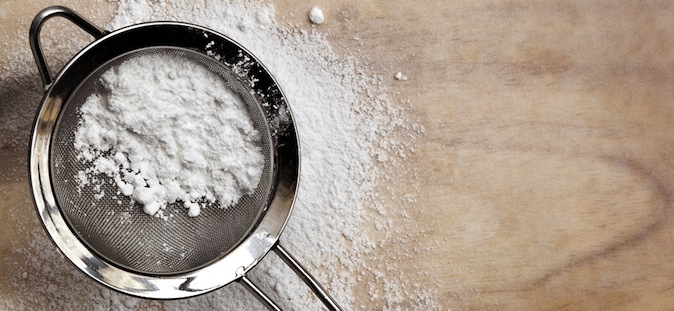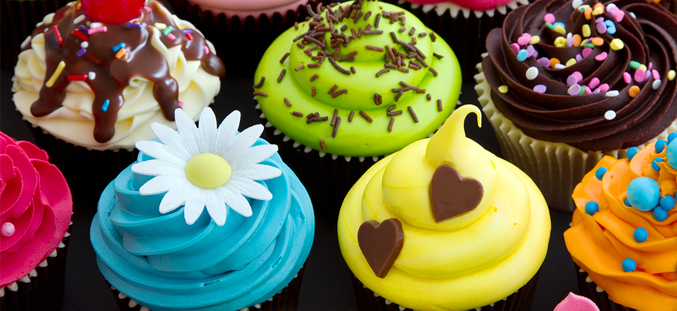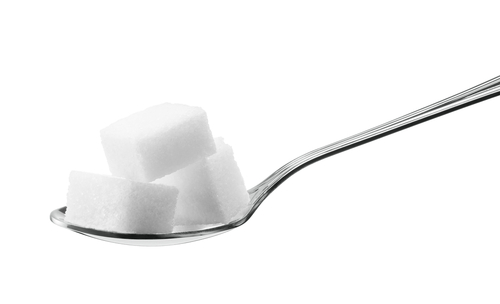A draft report by the Scientific Advisory Committee on Nutrition has recommended Britons halve their sugar intake. So what’s behind sugar’s new status as Public Enemy No. 1? Healthista Investigates
When it comes to health hype, never before has sugar been more bittersweet. A draft report by the Scientific Advisory Committee on Nutrition (SACN) has today recommended Britons should halve their sugar intake from 12 per cent of their current calories to just five per cent – the equivalent of one fizzy drink or for women, about 5-6 teaspoons.
The body reviewed 600 scientific papers and found strong links between high sugar consumption in the form of fizzy drinks, fruit juices and every day foods and obesity and diabetes.
While for most of us us, cupcakes and sweet treats are perfectly legal pick-me-ups for overworked minds, to a legion of scientists waging war on our sugar habits, they’re a bona-fide addiction that’s making us fat, wrinkley, affecting our moods and increasing our risk of disease. These aren’t fringey food cranks either but globally respected doctors and academics.
It all kicked off when chief anti-sugar high priest, Dr Robert Lustig, a paediatric endocrinologist at the University of California called for a ‘sugar tax’ claiming the white stuff is as dangerous as tobacco and ranted against its evils in a YouTube video that instantly went viral.
Now, Public Health England are investigating whether a tax on sugary drinks might help us lower our food intake. They’re also reconsidering their recommendations on fruit juice – right now, the NHS deems fruit juice as counting towards one portion of your fruit and veg a day.
But even so, look at the cupcake boom and you’ll see sugar has become our ultimate cheer up treat. This is less about the emotional legacy of being rewarded with Spangles as children and more about primal urge, says Aubrey Sheiham, professor of Public Health at University College London.
WE WE LIKE SWEET STUFF
‘We evolved to like sweetness because everything in nature that was sweet was safe to eat,’ he explains. ‘We have done experiments with anencephalic babies, those with no brains, and when a drop of sugar is put on their tongues they smile. That’s a primitive response to sweet tastes.’ But 10,000 years ago our ancestors would have had rare forms of sugar mostly from in-season whole fruits. While this primal love of sweetness has remained with us, sugar is much more available today in ever more refined forms – in supermarkets, newsagents, take-aways, cafes, delis and train stations – so we eat it. And eat it. Worldwide, consumption of sugar has tripled in the last 50 years and in Britain, we each consume around 22 kilograms of the stuff a year. Still, ‘Our bodies have no physiological need for added sugar,’ says Sheiham. ‘You could have no sugar in your diet and be perfectly healthy.’
HOW SUGAR LURKS
You would be surprised how quickly it adds up. Scientists at Cambridge University found that many people are consuming up to four times their daily recommended limit for sugar because so many hidden sugars are added to everyday foods – including rye biscuits and slimming drinks (a Which? Report found that some savoury foods contain more sugar than ice cream). ‘Ribena may say ‘no sugar added’ but look on the back and they have sugars added by another name,’ says Professor Sheiham. ‘Table sugar is known as sucrose but drinks and foods may include glucose, fructose, maltose and other –oses. If something has an -ose on the end in the ingredients it’s sugar.’
AS ADDICTIVE AS COCAINE?
That ‘more-ish’ effect of the chocolate Digestive might not be down to your lack of will alone. In his new book Sugar Nation: The Hidden Truth Behind America’s Deadliest Habit and the Simple Way to Beat It Jeff O’Connell explains shockingly, how scientists at Princeton University have repeatedly shown in animal studies and studies on humans using MRI brain scans that sugar prompts release in the brain of the nerve neurotransmitter dopamine which travels the same neural pathways as cocaine and heroin. ‘Dopamine is the pleasure chemical released in substance abuse that makes you feel instantly better so you want to replicate the sensation,’ he explains. ‘Like any addictive substance, over time you need more sugar to get the same high.’
If cakey, floury treats are your thing, you may be reacting to a chemical in gluten, present in wheat flour, says Dr John Briffa in his book, Escape the Diet Trap (Fourth Estate £14.99). ‘Gluten contains a chemical called gliadin that binds to opiate receptors in the brain,’ he explains. ‘For people sensitive to it, it makes them feel instantly better but leaves them wanting more.’
THE MORE YOU EAT, THE MORE YOU WANT
The cravings culprit could be your lunch. ‘Low blood sugar is the most likely cause of a desire for sweet foods,’ says Dr Briffa. When someone eats, their body releases sugar into the blood stream and the pancreas secretes the hormone insulin whose function it is to take the sugar out of the blood stream and into the body’s cells where it can be used for fuel. ‘But refined starches such as breads, pasta, bagels, baguettes and cereals, typical lunch foods, along with crisps or sweet drinks like smoothies and juices make insulin levels soar quickly and then drop again fast to levels even lower than before you ate. That can mean cravings for fast glucose to refuel the blood a couple of hours later,’ he says. This reactive hypoglycaemia is common and can come with fatigue, fogginess, mood swings and anxiety. ‘Some people think they’re having a panic attack when it’s low blood sugar’, he says.
The more you eat the more you want, found researchers at the universities of Bristol and Bangor who discovered drinking two sugary drinks a day – including pure fruit juice and smoothies – made people crave even sweeter food and drink later. Add mental strain and the process is compounded.
‘The brain is sugar dependent, it uses about a quarter of the sugar in the blood stream at rest and if it doesn’t get enough, concentration and focus suffer and intense sugar cravings result,’ says Briffa. Research by Dr Roy Baumeister at Florida State University has shown that stress and fatigue undermine will power which explains why someone who starts the day off on the diet straight and narrow might find themselves inhaling strawberry sponge at 4.15pm.
HOW IT MAKES YOU OLD
Sugar is increasingly being revealed as a skin saboteur. A study published in the Journal of the American College of Nutrition, in which researchers studied the diets of 453 adults living in different countries and found that those who consumed more fish, olive oil and legumes were less prone to wrinkles than those who ate more sugar and refined carbohydrates. In particular soft drinks, sugar and pastries were associated with more skin wrinkling, while beans, green leafy vegetables, asparagus, nuts, olives, apples and pears were associated with less skin ageing.
‘A diet high in sugar and high glycaemic carbohydrates such as breads, rice, starches, potatoes, baked goods, pastas, desserts and soft drinks can lead to glycation in the skin,’ says Dr Nicholas Perricone, dermatologist and leading authority on diet and ageing. This produces chemical compounds called Advanced Glycation Endproducts (AGEs) that bind with skin proteins to create a chemical reaction in skin that makes its surface more stiff and inflexible, leading to premature ageing. ‘Sugar molecules attach to collagen fibres and cause them to lose their strength so skin becomes more vulnerable to sun damage, lines and sagging.’
LINK WITH CANCER?
Diets high in sugar have recently become a focus of cancer researchers. ‘Insulin is an anabolic hormone, which means it makes things grow,’ says Jeff O’Connell. Though not conclusive, the theory is that constant insulin surges from a high sugar diet may feed tumour growth as some researchers now believe that common cancers such as breast and colon have something called ‘insulin receptors’ on their surface. ‘The links between sugar and cancer seem more and more compelling,’ says O’Connell.
HOW IT MAKES YOU FAT
Where once we obsessed over fatty chicken skin or oily dressing now, sugar has become the new fat. A study at Cambridge University’s Medical Research Council found that overweight people ate nearly three times as much sugar daily as their thinner counterparts. ‘In response to sugar in the blood the pancreas produces insulin,’ says Professor Charles Clark, author of The Diabetes Revolution: A groundbreaking guide to reducing your insulin dependency. ‘This instructs the liver to metabolise dietary fat and convert extra sugar in the blood into triglycerides, a form of blood fat. These triglycerides are then transported back into the blood and taken up by fat cells which is how sugar turns into fat’.
ARE ARTIFICIAL SWEETENERS THE ANSWER?
Studies show that people who drink diet drinks have a 200 per cent chance of being overweight and a 57 per cent increased risk of diabetes. ‘Whether it’s honey, table sugar, artificial sweetener or a diet drink when your body gets something sweet, it produces insulin and that triggers a response that makes you store fat,’ says Dr Mark Hyman, in his book The Blood Sugar Solution: The Bestselling Programme for Preventing Diabetes, Losing Weight and Feeling Great(Hodder £14.99). Hyman is the US medic credited with reversing Bill Clinton’s health in 2010. ‘ Diet drinks also make you hungrier by messing with your body’s satiety and hormonal signals.’
LINKS TO TYPE-2 DIABETES
A high-low cycle of insulin release from constant sugar hits can lead your body to become numb to insulin’s effects so you need more and more to get blood sugar even, a condition known as insulin resistance, says Hyman. Eventually, cells may stop being able to process insulin altogether and lead to Type-2 diabetes. In the last seven years, cases of Type 2 diabetes have increased by 50 per cent in Britain and an estimated 850,000 people in the UK have the disease and don’t know it.
‘If you eat a lot of flour and sugar and often experience low blood sugar symptoms such as mood swings and feeling faint if you don’t eat, you may be raising your risk of developing insulin resistance and subsequent Type-2 diabetes,’ he says. This also raises risk of a pre-diabtetes clinical syndrome known as diabesity, he says.
Though the word is a combination of obesity and diabetes, it refers to symptoms ranging in severity from blood-sugar related tension, anxiety and irritability between meals to insulin resistance, raised risk of heart disease and high blood pressure. While it’s common in around 80 per cent of the overweight, Dr Hyman explains 20-40 per cent of slim people – Hyman calls them ‘skinny fat’ – could be at risk of diabesity and not know it. ‘If you eat lots of sugar and carbohydrates, have skinny arms and legs and a thicker waist, you carry visceral fat,’ he explains. ‘It’s the fat associated with diabesity and more dangerous than subcutaneous fat as it surrounds the internal organs and raises your risk of diabetes, strokes and heart disease’.
BREAKING THE HABIT
By cutting added sugars, flour and refined carbohydrates from your diet in favour of lean proteins, vegetables, whole grains, fruits and moderate exercise, you can lose your dependence on sugar, Hyman says.
So, cold turkey, then? Withdrawals from sugar and refined carbohydrates could include cravings, headaches, low energy, irritability and even jitters and night sweats but they usually take just four to seven days to subside before cravings start to wane.
‘Try it for 21 days and see if your energy and mood improve,’ Hyman suggests. ‘If you’re eating in a way that balances your blood sugar you won’t have the low blood sugar that leads to cravings and energy dips because your body makes a steady supply of sugar from the protein and vegetables in your diet and from your fat stores,’ he says. ‘The body responds quickly and feeling better makes people want to keep going.’
RELATED:
Editor’s blog: 90 day sugar detox – 6 things to help the pain of giving up sugar
Video: hidden sugars in your ‘healthy’ drinks
Like this article? Sign up to our newsletter to get more articles like this delivered straight to your inbox.























































